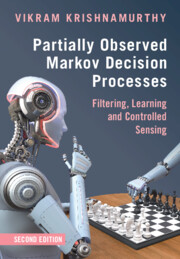Refine search
Actions for selected content:
6829 results in Communications and signal processing
17 - Reinforcement Learning
- from Part IV - Stochastic Gradient Algorithms and Reinforcement Learning
-
- Book:
- Partially Observed Markov Decision Processes
- Published online:
- 16 May 2025
- Print publication:
- 05 June 2025, pp 445-465
-
- Chapter
- Export citation
Bibliography
-
- Book:
- Partially Observed Markov Decision Processes
- Published online:
- 16 May 2025
- Print publication:
- 05 June 2025, pp 605-628
-
- Chapter
- Export citation
9 - POMDPs in Controlled Sensing and Sensor Scheduling
- from Part II - POMDPs. Models, Algorithms and Applications
-
- Book:
- Partially Observed Markov Decision Processes
- Published online:
- 16 May 2025
- Print publication:
- 05 June 2025, pp 231-254
-
- Chapter
- Export citation
16 - Stochastic Optimization and Gradient Estimation
- from Part IV - Stochastic Gradient Algorithms and Reinforcement Learning
-
- Book:
- Partially Observed Markov Decision Processes
- Published online:
- 16 May 2025
- Print publication:
- 05 June 2025, pp 425-444
-
- Chapter
- Export citation
Part II - POMDPs. Models, Algorithms and Applications
-
- Book:
- Partially Observed Markov Decision Processes
- Published online:
- 16 May 2025
- Print publication:
- 05 June 2025, pp 163-164
-
- Chapter
- Export citation
Preface to Revised Edition
-
- Book:
- Partially Observed Markov Decision Processes
- Published online:
- 16 May 2025
- Print publication:
- 05 June 2025, pp xii-xiv
-
- Chapter
- Export citation
4 - Algorithms for Maximum Likelihood Parameter Estimation
- from Part I - Stochastic Models and Bayesian Inference
-
- Book:
- Partially Observed Markov Decision Processes
- Published online:
- 16 May 2025
- Print publication:
- 05 June 2025, pp 71-90
-
- Chapter
- Export citation
12 - Monotonicity of Value Function for POMDPs
- from Part III - POMDP Structural Results
-
- Book:
- Partially Observed Markov Decision Processes
- Published online:
- 16 May 2025
- Print publication:
- 05 June 2025, pp 312-326
-
- Chapter
- Export citation
Contents
-
- Book:
- Partially Observed Markov Decision Processes
- Published online:
- 16 May 2025
- Print publication:
- 05 June 2025, pp v-xi
-
- Chapter
- Export citation
5 - Multiagent Sensing: Social Learning and Data Incest
- from Part I - Stochastic Models and Bayesian Inference
-
- Book:
- Partially Observed Markov Decision Processes
- Published online:
- 16 May 2025
- Print publication:
- 05 June 2025, pp 91-113
-
- Chapter
- Export citation

Inverse Problems and Applications
- Inside Out II
-
- Published online:
- 30 May 2025
- Print publication:
- 17 December 2012

Partially Observed Markov Decision Processes
- Filtering, Learning and Controlled Sensing
-
- Published online:
- 16 May 2025
- Print publication:
- 05 June 2025
Preface
-
- Book:
- Theory of Image Formation
- Published online:
- 17 April 2025
- Print publication:
- 24 April 2025, pp xiii-xv
-
- Chapter
- Export citation
6 - Tomographic Imaging Systems
-
- Book:
- Theory of Image Formation
- Published online:
- 17 April 2025
- Print publication:
- 24 April 2025, pp 207-253
-
- Chapter
- Export citation
2 - Signals in One Dimension
-
- Book:
- Theory of Image Formation
- Published online:
- 17 April 2025
- Print publication:
- 24 April 2025, pp 30-74
-
- Chapter
- Export citation
Contents
-
- Book:
- Theory of Image Formation
- Published online:
- 17 April 2025
- Print publication:
- 24 April 2025, pp vii-xii
-
- Chapter
- Export citation
9 - Diffraction Imaging Systems
-
- Book:
- Theory of Image Formation
- Published online:
- 17 April 2025
- Print publication:
- 24 April 2025, pp 350-398
-
- Chapter
- Export citation
Dedication
-
- Book:
- Theory of Image Formation
- Published online:
- 17 April 2025
- Print publication:
- 24 April 2025, pp vi-vi
-
- Chapter
- Export citation
3 - Signals in Two Dimensions
-
- Book:
- Theory of Image Formation
- Published online:
- 17 April 2025
- Print publication:
- 24 April 2025, pp 75-118
-
- Chapter
- Export citation
7 - Construction and Reconstruction of Images
-
- Book:
- Theory of Image Formation
- Published online:
- 17 April 2025
- Print publication:
- 24 April 2025, pp 254-300
-
- Chapter
- Export citation
